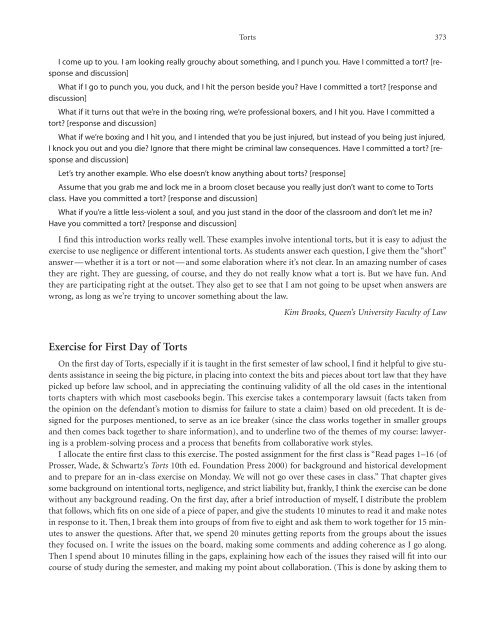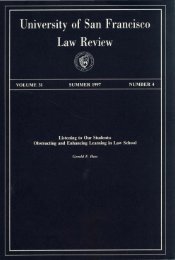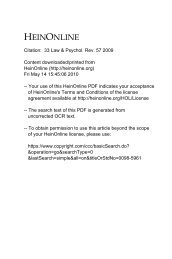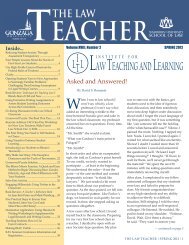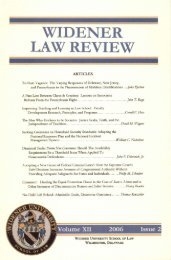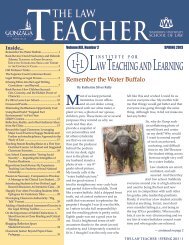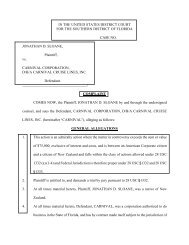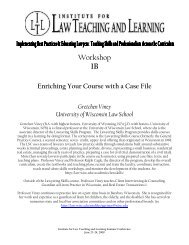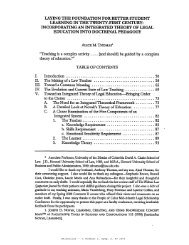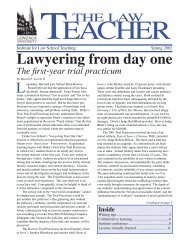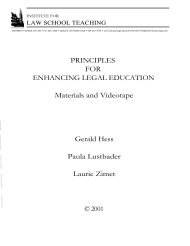Teaching the Law School Curriculum - Institute for Law Teaching ...
Teaching the Law School Curriculum - Institute for Law Teaching ...
Teaching the Law School Curriculum - Institute for Law Teaching ...
You also want an ePaper? Increase the reach of your titles
YUMPU automatically turns print PDFs into web optimized ePapers that Google loves.
Torts 373<br />
I come up to you. I am looking really grouchy about something, and I punch you. Have I committed a tort? [response<br />
and discussion]<br />
What if I go to punch you, you duck, and I hit <strong>the</strong> person beside you? Have I committed a tort? [response and<br />
discussion]<br />
What if it turns out that we’re in <strong>the</strong> boxing ring, we’re professional boxers, and I hit you. Have I committed a<br />
tort? [response and discussion]<br />
What if we’re boxing and I hit you, and I intended that you be just injured, but instead of you being just injured,<br />
I knock you out and you die? Ignore that <strong>the</strong>re might be criminal law consequences. Have I committed a tort? [response<br />
and discussion]<br />
Let’s try ano<strong>the</strong>r example. Who else doesn’t know anything about torts? [response]<br />
Assume that you grab me and lock me in a broom closet because you really just don’t want to come to Torts<br />
class. Have you committed a tort? [response and discussion]<br />
What if you’re a little less-violent a soul, and you just stand in <strong>the</strong> door of <strong>the</strong> classroom and don’t let me in?<br />
Have you committed a tort? [response and discussion]<br />
I find this introduction works really well. These examples involve intentional torts, but it is easy to adjust <strong>the</strong><br />
exercise to use negligence or different intentional torts. As students answer each question, I give <strong>the</strong>m <strong>the</strong> “short”<br />
answer — whe<strong>the</strong>r it is a tort or not — and some elaboration where it’s not clear. In an amazing number of cases<br />
<strong>the</strong>y are right. They are guessing, of course, and <strong>the</strong>y do not really know what a tort is. But we have fun. And<br />
<strong>the</strong>y are participating right at <strong>the</strong> outset. They also get to see that I am not going to be upset when answers are<br />
wrong, as long as we’re trying to uncover something about <strong>the</strong> law.<br />
Exercise <strong>for</strong> First Day of Torts<br />
Kim Brooks, Queen’s University Faculty of <strong>Law</strong><br />
On <strong>the</strong> first day of Torts, especially if it is taught in <strong>the</strong> first semester of law school, I find it helpful to give students<br />
assistance in seeing <strong>the</strong> big picture, in placing into context <strong>the</strong> bits and pieces about tort law that <strong>the</strong>y have<br />
picked up be<strong>for</strong>e law school, and in appreciating <strong>the</strong> continuing validity of all <strong>the</strong> old cases in <strong>the</strong> intentional<br />
torts chapters with which most casebooks begin. This exercise takes a contemporary lawsuit (facts taken from<br />
<strong>the</strong> opinion on <strong>the</strong> defendant’s motion to dismiss <strong>for</strong> failure to state a claim) based on old precedent. It is designed<br />
<strong>for</strong> <strong>the</strong> purposes mentioned, to serve as an ice breaker (since <strong>the</strong> class works toge<strong>the</strong>r in smaller groups<br />
and <strong>the</strong>n comes back toge<strong>the</strong>r to share in<strong>for</strong>mation), and to underline two of <strong>the</strong> <strong>the</strong>mes of my course: lawyering<br />
is a problem-solving process and a process that benefits from collaborative work styles.<br />
I allocate <strong>the</strong> entire first class to this exercise. The posted assignment <strong>for</strong> <strong>the</strong> first class is “Read pages 1–16 (of<br />
Prosser, Wade, & Schwartz’s Torts 10th ed. Foundation Press 2000) <strong>for</strong> background and historical development<br />
and to prepare <strong>for</strong> an in-class exercise on Monday. We will not go over <strong>the</strong>se cases in class.” That chapter gives<br />
some background on intentional torts, negligence, and strict liability but, frankly, I think <strong>the</strong> exercise can be done<br />
without any background reading. On <strong>the</strong> first day, after a brief introduction of myself, I distribute <strong>the</strong> problem<br />
that follows, which fits on one side of a piece of paper, and give <strong>the</strong> students 10 minutes to read it and make notes<br />
in response to it. Then, I break <strong>the</strong>m into groups of from five to eight and ask <strong>the</strong>m to work toge<strong>the</strong>r <strong>for</strong> 15 minutes<br />
to answer <strong>the</strong> questions. After that, we spend 20 minutes getting reports from <strong>the</strong> groups about <strong>the</strong> issues<br />
<strong>the</strong>y focused on. I write <strong>the</strong> issues on <strong>the</strong> board, making some comments and adding coherence as I go along.<br />
Then I spend about 10 minutes filling in <strong>the</strong> gaps, explaining how each of <strong>the</strong> issues <strong>the</strong>y raised will fit into our<br />
course of study during <strong>the</strong> semester, and making my point about collaboration. (This is done by asking <strong>the</strong>m to


